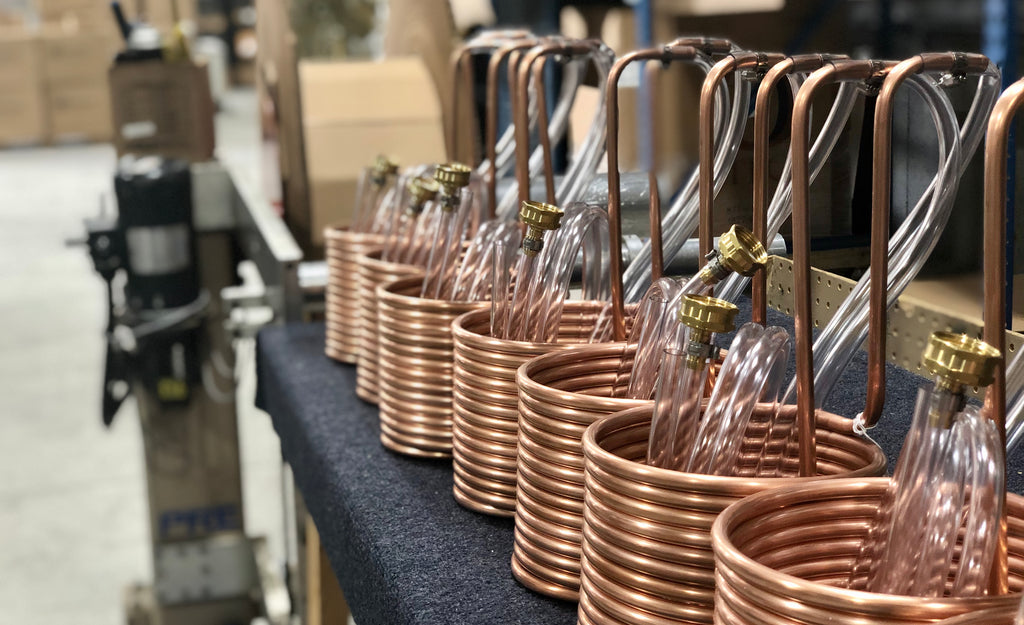Chiller Cleaning: Cleaning and Sanitizing an Immersion Chiller
Understanding the Importance of Wort Chiller Tube Cleaning
Chiller tube cleaning is essential for home brewers who rely on immersion chillers to cool their wort efficiently. These copper coils are submerged in hot wort, with cold water running through them, to rapidly bring down the temperature. Over time, contaminants and residues can accumulate on the chiller tubes, reducing their effectiveness. Ensuring clean chiller tubes is crucial for maintaining optimal heat transfer efficiency. Even a thin layer of buildup can significantly impact performance, leading to longer cooling times and potential off-flavors in the brew. Regular cleaning of the chiller tubes helps prevent these issues, ensuring that your brewing process remains efficient and your equipment lasts longer.
Initial Cleaning of your immersion chiller
Before using your brand new copper immersion chiller, it's crucial to remove any residual machine oil, particularly near the bends. Start by thoroughly cleaning the chiller with warm water and a mild degreaser, such as a fragrance-free dish soap or Star degreaser, and rinse well. Using a new dish scrubber on the outside is also an effective method to eliminate any leftover debris, ensuring your chiller is ready for efficient use in your home brewing process. Wash, rinse, then rinse again.

Patina & Dull Oxide Layer Impact on Heat Transfer Efficiency
Inevitably, your copper immersion wort chiller is going to tarnish and become slightly deformed. They are manufactured with soft copper, it’s science. Rest assured, the performance of your chiller will remain top notch as long as you don’t abuse it.
If your immersion chiller ever becomes blue-green (from verdigris—the patina on the Statue of Liberty), you need to remove it before use.
In case of extreme oxidation and dirtiness, you can also soak your chiller in a diluted distilled white vinegar solution or PBW to get that clean copper shine back. Rinse thoroughly. Then rinse again. For tough deposits, consider using plastic or metal scrapers to effectively remove them.
Cleaning Ratio
White Vinegar - 6oz / 5 gallons
PBW - 1oz per gallon

Sanitizing your immersion wort chiller
Many home brewers will sterilize their chiller in their wort during the last 15 minutes of boil. Another option is to boil the chiller in a separate pot, but its unnecessary if your chiller is relatively clean to begin with. Soaking you wort chiller in StarSan for 20 minutes will brighten and sanitize your chiller.
Sanitizing Ratio
Star San - 1oz / 5 gallons

Chiller Tube Cleaning Method
Post Chilling
When you are done chilling, immediately rinse your chiller or place it into a 5 gallon bucket of water until you can properly rinse it. Do not let it sit out and dry. The hop residue and cold break will dry and stick to the copper making it more difficult to clean. Using cleaning systems that combine compressed air with water can effectively remove deposits and improve the efficiency of tube cleaning.
Best Practices for Home Brewing Chiller Maintenance
To ensure your home brewing chiller remains efficient and effective, it's important to adopt a hands-on approach to maintenance. Here are some key practices:
-
Regularly clean the chiller tubes after each use to prevent the buildup of wort residue and contaminants that can affect your brew's flavor.
-
Use simple cleaning tools such as plastic brushes or a soft cloth with mild soap to gently scrub the copper coils without causing damage.
-
Use mild chemicals like PBW and StarSan, which are excellent for home brewing, to effectively clean and sanitize your chiller without leaving harmful residues. These solutions help remove tarnish and maintain the copper's shine.
-
Rinse the chiller thoroughly with clean water after every cleaning session to ensure no soap or cleaning agents remain on the coils.
-
Store the chiller in a dry place to prevent any moisture-induced corrosion or buildup.
By following these straightforward practices, home brewers can keep their copper immersion chillers in peak condition, ensuring efficient cooling and preserving the quality of their brews. Regular maintenance helps extend the life of the chiller and contributes to consistent brewing success.
